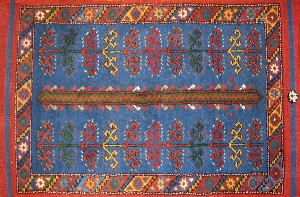An Antipodean Alchemy –
The Eucalypt Dyes
by India Flint
The eucalypts are members of an evergreen hardwood genus endemic to the Australasian region embracing approximately nine hundred species and sub-species. Eucalypts are represented across the Australian continent in all but the harshest of the arid interior regions, although they can be found in desert areas marking the positions of soaks and watercourses. Their range extends to 9º N (Philippines) and as far south as 44º S in Tasmania, with the greatest variety of species concentrated in the temperate zones. Eucalypts have successfully colonized many other parts of the world including southern Europe, Asia and the west coast of the United States.
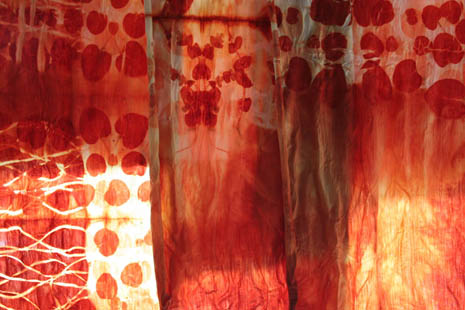
Photograph Copyright by India Flint
Dyes from this genus are substantive on protein fibers (e.g., wool, silk), meaning that color can be fixed without the use of additive chemical mordants. The colors obtained range from a deep rust red through all shades of tan and brown, to golds and greens. Leaves from eucalypts will give different colors depending on whether they are used fresh, dried or collected from the ground beneath the tree. Picking fresh leaves from Eucalyptus sideroxylon, for example, can yield dark rust red from the sunny side of the tree; leaves from a side that is shaded by other trees or a house will often give a warm apricot. Picking very young leaves from the same tree on the day after heavy rains might yield a golden green (depending on the year and the ambient temperature as well!). Collecting leaves that have fallen beneath the same tree and been toasted by a long summer will give a chocolate brown. Material processed from one species that has been grown in different geographic locations may also offer dramatically different dye results.
Additional variables may be created through the choice of dye processes. All these colors are obtained by simply processing in rainwater in a non-reactive vessel. The traditional approach is to extract the dye by boiling the leaves in water, straining off the liquor, and then heating the textile in the solution. Another option is 'solar dyeing': the plant material and the textile to be dyed are placed in close contact (with added water) in an airtight container, and left in a sunny spot for at least four weeks (and sometimes months). Although almost every plant in the world will yield some kind of color to cloth–and I use many plants growing in my garden and wider region–the genus eucalyptus is indubitably my favorite source of dye. Add in variables such as pots made of different metals and different qualities of water and the color range increases. Factor in the possibilities offered by adding mordants (of which I use only those of relatively low toxicity: ash, fruit vinegars, urine and so on) and you can see how one could happily occupy oneself making dyes from just the one tree for many years to come!
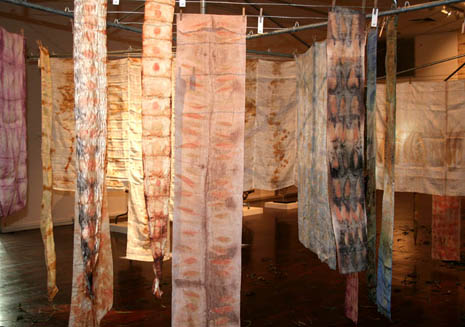
Photograph Copyright by India Flint
I have long been fascinated by dress and the adornment of the body in what might be termed a kind of 'intimate architecture'. My work questions the nature of fashion in relation to sustainability and has its foundation in the garment as a handcrafted object. It is realized in costume design (recent commissions include costumes for the West Australian Ballet company and work for Leigh Warren & Dancers at the Yamaguchi Centre for Arts and Media) and through the independent label shown from time to time at exhibitions or available as sartorial salvage by (re)commission. Each garment is individually fabricated or re-fashioned by hand, embellished with stitch and sometimes with hand-formed wool felt, dyed using ecologically sustainable plant dyes and signed with the eucalyptus eco-print© as my maker's mark. I discovered the eucalyptus eco-print during research as an MA candidate in 1999. It is substantive on protein fibres without chemical adjuncts and offers a means of assessing the range of dye colours contained within individual leaves.
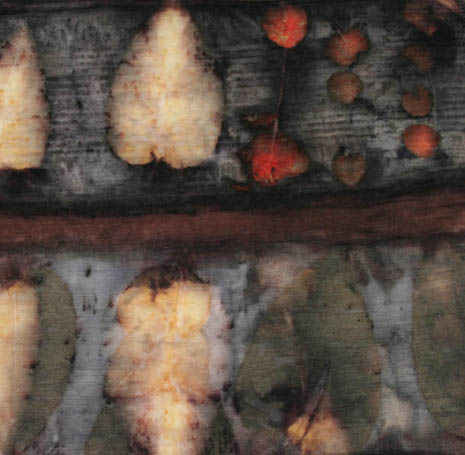
Photograph Copyright by India Flint
The label honors the stitch and the dress-up box, cherishes fragments, rummages contentedly in grandmother's button jar and remembers old stories. It brings nature into the city, features materials and techniques both old and new, and explores social as well as ecological sustainability in fashion. For wearer comfort and well-being, only natural materials (including silk, cotton, wool, ramie, linen and hemp) are used. In modern consumer culture, this week's T-shirt is often next month's landfill, as popular emporia offer new stock on a weekly basis encouraging spending on poorly made mass-produced garments destined for pathetically short lives. Given the high environmental, social and economic cost of materials production it is desirable to extend the useful life of cloth and clothing as long as possible.
I make individually dyed hand-sewn clothes designed for long life made from salvaged materials supplemented by new silks and wools. The garments are embellished with found fragments and stitching, and layers of dyes which come largely from eucalypts harvested from both cultivated and windfall sources and from roadside weeds augmented by plants purpose-grown in the farm garden. Making re-crafted clothing, in which each piece is unique and individually considered, it is a slower kind of fashion, like slow food.
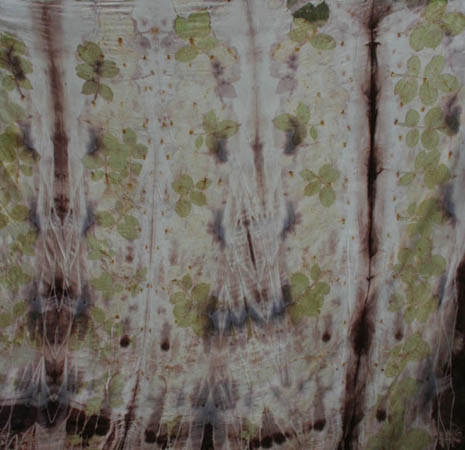
Photograph Copyright by India Flint
I also offer a r(eco)mmissioning service whereby garments can be brought back to the workroom for 'negotiated maintenance', where I discuss with the client whether simple darning, restitching or over-dyeing are required or whether it is time for a more radical restructuring of the garment in order to give the client a 'new look' and thus prolong the useful life of the materials and modification, or a collection of discarded clothes can be re-deployed into something else for the client. A stain may become the centre of a flower, a tear begin a lace-like intervention, a decorative darn introduced, or the garment refreshed and rejuvenated in a eucalyptus dye bath. At the very end of its wearable life the garment can be transformed into string, or become part of a patched and pieced quilt. The philosophy is one of respect for the materials, for the environment and for the maker(s).
In March 2008 Murdoch Books (Sydney, Australia) will publish my book on eco-colorants for cloth, tentatively entitled "Botanical Alchemy", comprising recipes for dyes and alternative mordants to assist dyers around the world to coax color into cloth using ecologically sustainable methods and avoiding toxic chemical adjuncts. Dyeing for life, as it were.
 Turkey Red Journal
Turkey Red Journal
